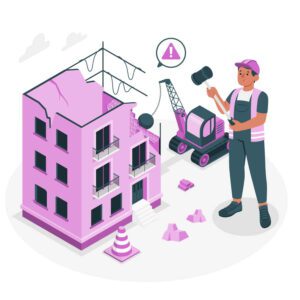Home and building demolition is a complex process that requires meticulous planning, expert knowledge, and a strong focus on safety. Whether you’re renovating your property or clearing a site for new construction, following safe demolition practices is crucial to prevent accidents and minimize environmental impact.
Tips for Safe Home and Building Demolition
In this article, we’ll explore essential tips for ensuring a safe and successful home and building demolition.
Discover essential safety guidelines for successful home and building demolition. Learn how to mitigate risks, hire experienced contractors, handle hazardous materials, and create a safe demolition plan. Safeguard your project and ensure the well-being of workers and the environment. Read now for expert insights.
- Hire a Licensed and Experienced Demolition Contractor
Before embarking on a demolition project, it’s imperative to hire a licensed and experienced demolition contractor. Look for professionals with a proven track record in handling similar projects and who are well-versed in local regulations and safety standards.

An experienced contractor will conduct a thorough assessment of the site, identify potential hazards, and develop a comprehensive demolition plan.
- Obtain Necessary Permits and Approvals
Demolition projects often require permits and approvals from local authorities. Failing to secure the appropriate permits can result in legal issues and project delays.

Your chosen demolition contractor should help you navigate the permitting process and ensure that all necessary approvals are obtained before commencing work.
- Conduct a Hazard Assessment
Safety begins with a comprehensive hazard assessment of the site. Identify potential risks, such as hazardous materials (asbestos, lead, etc.), unstable structures, or utility lines.

A professional assessment will guide the development of a safe demolition strategy and determine the appropriate safety measures to implement.
- Develop a Detailed Demolition Plan
A well-defined demolition plan is the cornerstone of a safe project. The plan should outline the sequence of demolition, machinery and equipment to be used, waste disposal procedures, and emergency protocols.

This plan serves as a roadmap for the entire project and ensures that all team members are aligned.
- Implement Proper Engineering Controls
Engineering controls involve techniques that minimize exposure to hazards. These controls might include shoring up walls or structures to prevent unexpected collapses, erecting protective barriers to contain dust and debris, and ensuring proper ventilation to mitigate exposure to hazardous materials.

- Use Personal Protective Equipment (PPE)
Proper PPE is essential for the safety of workers and anyone else on the site. Ensure that all personnel involved in the demolition wear appropriate PPE, including hard hats, gloves, eye protection, respiratory masks, and protective clothing.

- Safe Handling of Hazardous Materials
If the building contains hazardous materials like asbestos, lead, or chemicals, their removal and disposal must adhere to strict safety regulations. Specialized contractors should handle these materials, employing safe removal and disposal practices.

- Secure Utilities
Before starting the demolition, disconnect and cap off all utilities, including water, gas, electricity, and telecommunications. This prevents accidental damage and reduces the risk of fires, explosions, and electrocutions.

Demolition Waste Management: Embracing Recycling and Sustainable Practices
- Monitor Weather Conditions
Weather conditions can significantly impact demolition projects. Strong winds, heavy rain, or extreme temperatures can create hazardous conditions for workers and compromise the stability of structures. Monitor weather forecasts closely and adjust your schedule accordingly.

- Emergency Response Plan
Even with meticulous planning, unexpected situations can arise during demolition. Have a well-defined emergency response plan that outlines procedures for handling accidents, injuries, fires, or structural failures. All team members should be familiar with this plan.

Guidelines for Home & Building Demolition by United States Environmental Protection Agency
Conclusion:
Safe home and building demolition requires careful planning, adherence to regulations, and a commitment to best practices. By hiring experienced professionals, obtaining necessary permits, and implementing comprehensive safety measures, you can ensure a successful demolition project that protects the well-being of workers, the environment, and the community at large.
Prioritizing safety from the outset will result in a smooth process and a positive outcome for everyone involved.
Other Interesting Posts To Read:
Deconstruction vs. Demolition: Making the Right Choice
Sustainable Demolition: Reducing Waste and Environmental Impact
The benefits of donating unwanted items to charity or non-profit organizations
5 Reasons Why Recycling Should Be a Priority in Your Community

1 thought on “Tips for Safe Home and Building Demolition”